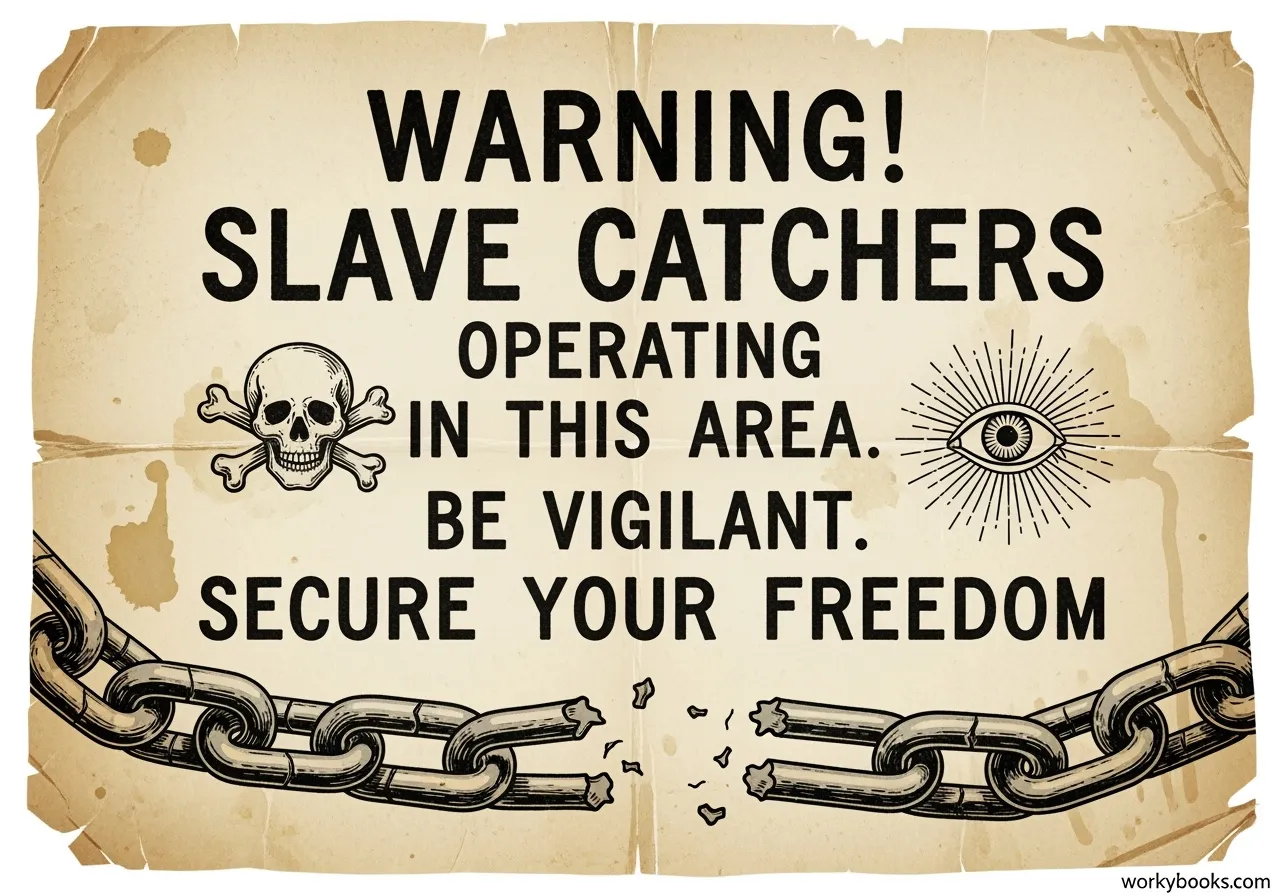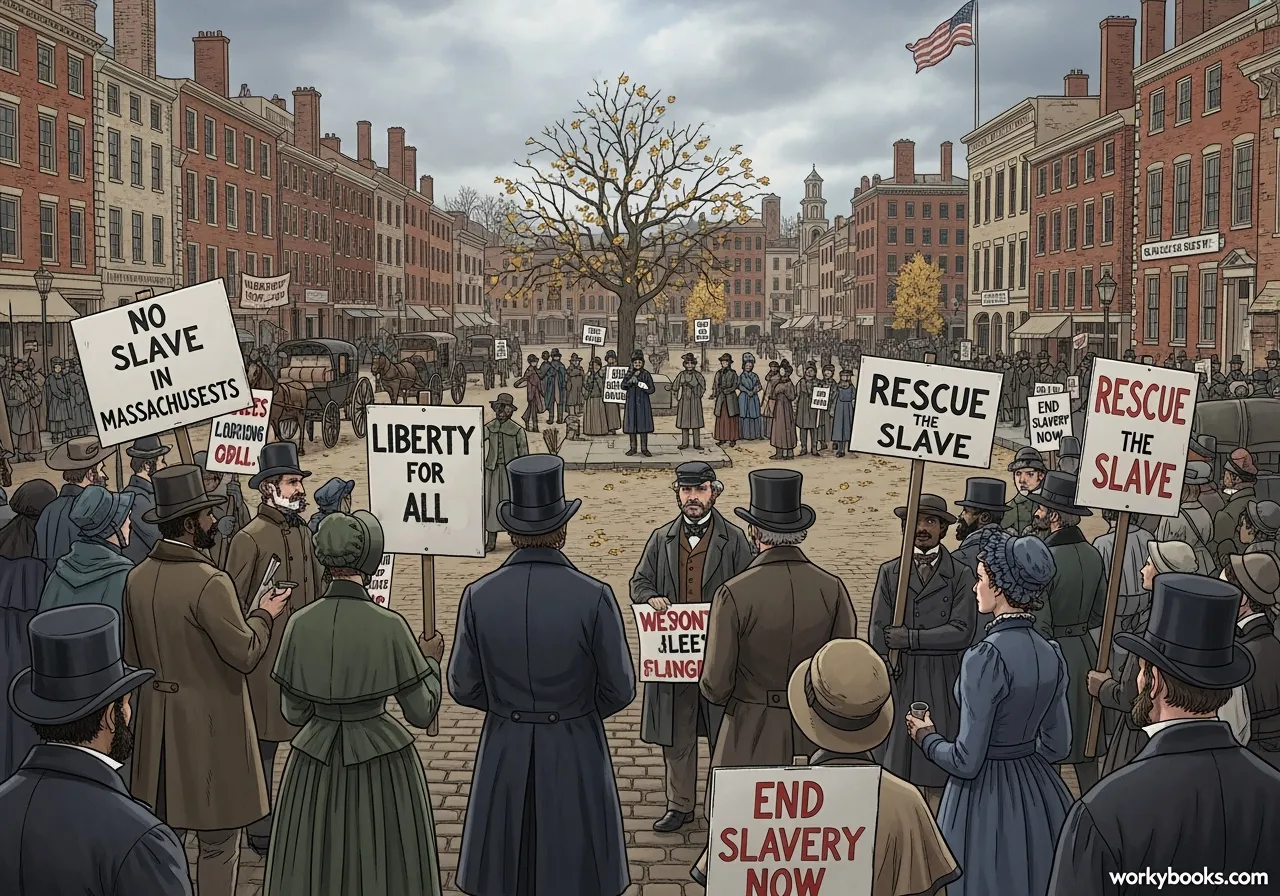Fugitive Slave Law
Learn about the laws that required the return of escaped slaves and their impact on American history
What Was the Fugitive Slave Law?

The Fugitive Slave Laws were laws passed by the United States Congress that required the return of escaped enslaved people to their owners. The first Fugitive Slave Act was passed in 1793, but the most famous one was the Fugitive Slave Act of 1850.
These laws meant that even if an enslaved person escaped to a free state where slavery was illegal, they could still be captured and returned to slavery. The laws applied throughout the United States, including in states that had outlawed slavery.
Did You Know?
The Fugitive Slave Act of 1850 denied escaped enslaved people the right to a jury trial and even required citizens to help capture runaway slaves if asked!
Fugitive Slave Act of 1850

The Fugitive Slave Act of 1850 was a stronger version of the original 1793 law. It was part of the Compromise of 1850, which tried to settle disagreements between slave states and free states.
This law had several harsh provisions:
No Jury Trial
Escaped enslaved people were not allowed a jury trial to prove they were free
Commissioners Paid More
Commissioners were paid $10 for returning someone to slavery but only $5 for freeing them
Citizens Required to Help
Ordinary citizens could be forced to help capture runaway enslaved people
These provisions made the 1850 law very controversial and increased tensions between Northern and Southern states.
Compromise of 1850

The Compromise of 1850 was a package of five laws passed by Congress to address tensions between slave states and free states. The Fugitive Slave Act was the most controversial part of this compromise.
The Compromise of 1850 included:
- California entered the Union as a free state
- New Mexico and Utah territories could decide on slavery themselves
- Texas received $10 million to give up land claims
- The slave trade (but not slavery) was banned in Washington, D.C.
- The Fugitive Slave Act of 1850 was strengthened
While the compromise temporarily eased tensions, the harsh Fugitive Slave Act actually increased anger in the North and strengthened the abolitionist movement.
Missouri Compromise
Maintained balance between slave and free states
Compromise of 1850
Included the Fugitive Slave Act as one of five bills
Kansas-Nebraska Act
Allowed territories to decide on slavery, causing more conflict
Abolitionists and Resistance

Abolitionists were people who worked to end slavery. They strongly opposed the Fugitive Slave Laws and worked to help escaped enslaved people remain free.
Famous abolitionists included:
Frederick Douglass
Escaped slave who became a powerful speaker and writer against slavery
Harriet Beecher Stowe
Author of "Uncle Tom's Cabin" which showed the cruelty of slavery
Harriet Tubman
Escaped slave who helped many others escape via the Underground Railroad
Abolitionists used speeches, newspapers, books, and direct action to resist the Fugitive Slave Laws. Some Northern states passed "personal liberty laws" that tried to protect free Black people from being captured as fugitive slaves.
The Underground Railroad

The Underground Railroad was a secret network of routes and safe houses that helped enslaved people escape to free states and Canada. It wasn't actually a railroad or underground, but the name described its secret nature.
The Fugitive Slave Act of 1850 made the Underground Railroad more important than ever, as escaped enslaved people were no longer safe even in Northern states.
Underground Railroad Terminology
- Conductors: People who guided escaping enslaved people
- Stations: Safe houses where escaping enslaved people could hide
- Station Masters: People who operated safe houses
- Passengers: Escaping enslaved people
- Tracks: The routes traveled
It's estimated that between 40,000 and 100,000 enslaved people escaped via the Underground Railroad between 1810 and 1850. The Fugitive Slave Act of 1850 made Canada the main destination since slavery was illegal throughout the British Empire.
Fugitive Slave Law Quiz
Test your knowledge about the Fugitive Slave Law! Answer all 5 questions to see how much you've learned.
Frequently Asked Questions
Here are answers to common questions about the Fugitive Slave Law:
Historical Trivia
Discover interesting facts about the Fugitive Slave Law and this period in history!
Legal Resistance
In 1854, abolitionists in Boston stormed a courthouse to rescue Anthony Burns, a captured fugitive slave. It took 2,000 troops to escort Burns to the ship that returned him to slavery.
Migration to Canada
After the Fugitive Slave Act of 1850 was passed, approximately 20,000 African Americans fled to Canada within just a few years to ensure their safety from slave catchers.
Literary Response
Harriet Beecher Stowe's novel "Uncle Tom's Cabin" (1852) was partly written in response to the Fugitive Slave Act and sold 300,000 copies in its first year.
Supreme Court Case
In the 1859 case Ableman v. Booth, the Supreme Court upheld the Fugitive Slave Act, ruling that states could not interfere with its enforcement.


